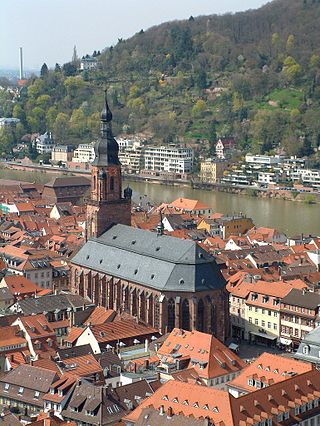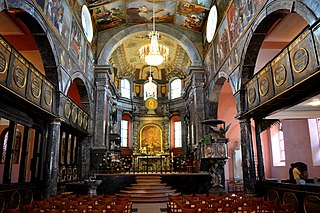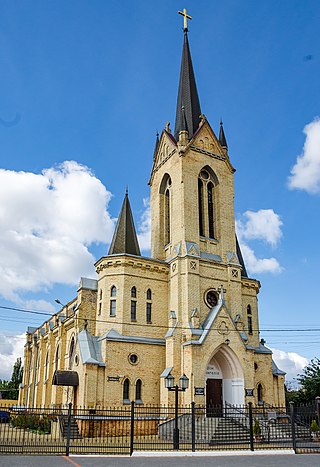
Romanesque architecture is an architectural style of medieval Europe that was predominant in the 11th and 12th centuries. The style eventually developed into the Gothic style with the shape of the arches providing a simple distinction: the Romanesque is characterized by semicircular arches, while the Gothic is marked by the pointed arches. The Romanesque emerged nearly simultaneously in multiple countries ; its examples can be found across the continent, making it the first pan-European architectural style since Imperial Roman architecture. Similarly to Gothic, the name of the style was transferred onto the contemporary Romanesque art.

Gothic architecture is an architectural style that was prevalent in Europe from the late 12th to the 16th century, during the High and Late Middle Ages, surviving into the 17th and 18th centuries in some areas. It evolved from Romanesque architecture and was succeeded by Renaissance architecture. It originated in the Île-de-France and Picardy regions of northern France. The style at the time was sometimes known as opus Francigenum ; the term Gothic was first applied contemptuously during the later Renaissance, by those ambitious to revive the architecture of classical antiquity.

St. Peter's Church, in German Petrikirche, was built in the 13th century and is the oldest of three town churches found in the Hanseatic city of Rostock, in northern Germany. The other two are St. Mary's Church (Marienkirche) and St. Nicholas (Nikolaikirche). A fourth, St. Jakobi, was heavily damaged during the Second World War and subsequently demolished.

Bremen Cathedral, named after St. Peter, is a church situated in the market square in the center of Bremen. The cathedral belongs to the Bremian Evangelical Church, a member of the umbrella organization Protestant Church in Germany. It is the previous cathedral of the former Prince-Archbishopric of Bremen. Since 1973, it is protected by the monument protection act.

The Church of the Holy Spirit is the largest church in Heidelberg, Germany. The church, located in the marketplace in the old town center, was constructed between 1398 and 1515 in the Romanesque and Gothic styles. It receives 1–3 million guests annually, making it among the most visited churches in Germany.

The Holy Cross Church is a Catholic church in the Bornheim district of Frankfurt am Main (Germany). It is similar in design to the Frauenfriedenskirche in Frankfurt-Bockenheim. It was built by Martin Weber from 1928 to 1929, on a rise then known as Bornheimer Hang. The church is an unusual example of interwar modernism as sacred Bauhaus architecture.

St Mary's Church in the village of Purton in north Wiltshire, England, is an active Church of England parish church in the Diocese of Bristol. A large building begun in the 13th century and one of only three churches in England to have both a western tower and a central spire, it has been designated as a Grade I listed building by English Heritage.

The Unionskirche is the active Protestant parish church of Idstein, a town in the Rheingau-Taunus district in the German state of Hesse. Idstein was a residence of the counts of Nassau. The church building in the center of the historic Altstadt dates back to the 14th century when it was built as a collegiate church. It became Lutheran during the Reformation. Its interior was adapted in the 17th century to become a Lutheran Predigt- und Hofkirche. The most prominent decoration in the church is the series of 38 paintings by the Flemish painter Michael Angelo Immenraedt, an exponent of Flemish Baroque painting, and others. They follow a program of biblical scenes.

House of the Gospel in Lutsk, Ukraine, is a Baptist church. It is located in "Old Lutsk", the historical and architectural part of the city.

Divi Blasii is a Gothic church in the Thuringian town of Mühlhausen, central Germany. Besides St Mary's, it is one of Mühlhausen's two principal churches. Divi Blasii is a three-aisle, cruciform hall church, situated on the Untermarkt in the historical centre of the town. The elaborately designed display façade with tracery, pinnacles and a wheel window on the north side is located on an old trade route. Today, Divi Blasii is the central parish church of the Lutheran parish of Mühlhausen within the Protestant Church in Central Germany.

St. Severin is a Lutheran parish church in Keitum on the island of Sylt, northern Germany. It was named after the 4th-century bishop Severin of Cologne. Built in the Romanesque style and first documented in 1240, the church stands back from the town at a higher elevation. Tests have shown that the roof of the church can be dated to 1216, making it the oldest religious building in Schleswig-Holstein. The tower was built around 1450 and served as a navigation mark for seafarers as well as a prison.

The Catholic Holy Cross Church is a Roman Catholic parish church in the southern German city of Augsburg, Bavaria. While its history dates back to 1143 when a hospice with a chapel was constructed on the site, the present church in the Gothic style was built by Provost Vitus Fackler in 1508. After bombing damage in the Second World War, rebuilding work was completed in 1949.

St. Lambert's Church is the main Evangelical Lutheran church in the centre of the city of Oldenburg, Lower Saxony, Germany.

The Holy Cross Church is a Catholic church in the Fröttmaning district of Munich (Germany). It is now the oldest preserved church in the city as Fröttmaning has been a part of Munich since 1931.

St. Jacobi is a Lutheran church and parish in Werther, North Rhine-Westphalia, Germany. The present building was begun in the 14th century, and was expanded in 1876. The parish became Lutheran in 1570.

St Mary's Church in the town of Stadtilm in Thuringia, Germany, is a Romanesque-Gothic church building and the landmark of the town. St Mary's Church is situated to the east of the market, separated by a row of houses. Its twin towers are 42 metres (138 ft) high and bear 2-metre-wide clock faces; the ringing has three bronze bells. Today, St Mary's Church is a Lutheran parish church; the parish belongs to the Arnstadt-Ilmenau district of the Evangelical Church in Central Germany.

The parish church of Kainach bei Voitsberg, often called Kainach parish church, is the Catholic parish church of the parish of Kainach, located in the municipality of Kainach bei Voitsberg in western Styria, Austria. The church, dedicated to St. George, belongs to the pastoral area of Voitsberg in the diocese of Graz-Seckau.

St. Christopher Church is the Protestant-Lutheran parish church located in the village of Reinhausen in the district of Göttingen, Lower Saxony. The church stands on the sandstone rock of the Kirchberg above the village center. It was originally built as a castle chapel by the Counts of Reinhausen in the 10th century and later served as a church for the collegiate monastery and the Benedictine monastery of Reinhausen that emerged from it in the 12th century. The church in Reinhausen, commonly known as the Reinhausen monastery church, has served as the parish church of the village of Reinhausen for many years. Following the introduction of the Reformation in 1542, the monastery was gradually dissolved, and the church was then solely used as a parish church, with brief interruptions. Today, it belongs to the Göttingen church district in the Hildesheim-Göttingen branch of the Hanoverian regional church.





















